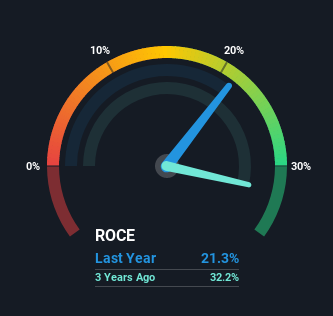- India
- /
- Trade Distributors
- /
- NSEI:SIGIND
Capital Allocation Trends At Signet Industries (NSE:SIGIND) Aren't Ideal

If we want to find a potential multi-bagger, often there are underlying trends that can provide clues. Ideally, a business will show two trends; firstly a growing return on capital employed (ROCE) and secondly, an increasing amount of capital employed. Basically this means that a company has profitable initiatives that it can continue to reinvest in, which is a trait of a compounding machine. So when we looked at Signet Industries (NSE:SIGIND), they do have a high ROCE, but we weren't exactly elated from how returns are trending.
Understanding Return On Capital Employed (ROCE)
If you haven't worked with ROCE before, it measures the 'return' (pre-tax profit) a company generates from capital employed in its business. Analysts use this formula to calculate it for Signet Industries:
Return on Capital Employed = Earnings Before Interest and Tax (EBIT) ÷ (Total Assets - Current Liabilities)
0.21 = ₹572m ÷ (₹7.4b - ₹4.7b) (Based on the trailing twelve months to September 2021).
Thus, Signet Industries has an ROCE of 21%. In absolute terms that's a great return and it's even better than the Trade Distributors industry average of 8.2%.
See our latest analysis for Signet Industries

Historical performance is a great place to start when researching a stock so above you can see the gauge for Signet Industries' ROCE against it's prior returns. If you want to delve into the historical earnings, revenue and cash flow of Signet Industries, check out these free graphs here.
So How Is Signet Industries' ROCE Trending?
On the surface, the trend of ROCE at Signet Industries doesn't inspire confidence. While it's comforting that the ROCE is high, five years ago it was 28%. However, given capital employed and revenue have both increased it appears that the business is currently pursuing growth, at the consequence of short term returns. If these investments prove successful, this can bode very well for long term stock performance.
On a separate but related note, it's important to know that Signet Industries has a current liabilities to total assets ratio of 63%, which we'd consider pretty high. This effectively means that suppliers (or short-term creditors) are funding a large portion of the business, so just be aware that this can introduce some elements of risk. While it's not necessarily a bad thing, it can be beneficial if this ratio is lower.
The Bottom Line On Signet Industries' ROCE
In summary, despite lower returns in the short term, we're encouraged to see that Signet Industries is reinvesting for growth and has higher sales as a result. But since the stock has dived 73% in the last five years, there could be other drivers that are influencing the business' outlook. Therefore, we'd suggest researching the stock further to uncover more about the business.
If you'd like to know more about Signet Industries, we've spotted 5 warning signs, and 2 of them can't be ignored.
Signet Industries is not the only stock earning high returns. If you'd like to see more, check out our free list of companies earning high returns on equity with solid fundamentals.
New: Manage All Your Stock Portfolios in One Place
We've created the ultimate portfolio companion for stock investors, and it's free.
• Connect an unlimited number of Portfolios and see your total in one currency
• Be alerted to new Warning Signs or Risks via email or mobile
• Track the Fair Value of your stocks
Have feedback on this article? Concerned about the content? Get in touch with us directly. Alternatively, email editorial-team (at) simplywallst.com.
This article by Simply Wall St is general in nature. We provide commentary based on historical data and analyst forecasts only using an unbiased methodology and our articles are not intended to be financial advice. It does not constitute a recommendation to buy or sell any stock, and does not take account of your objectives, or your financial situation. We aim to bring you long-term focused analysis driven by fundamental data. Note that our analysis may not factor in the latest price-sensitive company announcements or qualitative material. Simply Wall St has no position in any stocks mentioned.
About NSEI:SIGIND
Signet Industries
Primarily engages in merchant trading of various polymer and plastic granules in India.
Good value second-rate dividend payer.
Market Insights
Community Narratives




